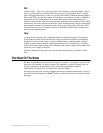
10 Handbook of Intercom Systems Engineering
sound powered system, but we do not discuss it here. Present day Party-Line intercom
systems may be wired or wireless or both.
System Components and Their Function
The system components for most Party-Line intercoms consist of power supplies (or
master stations), user stations (e.g. belt packs, speaker stations, main stations, etc.),
interconnecting cable, headsets, panel microphones, push-to-talk microphones, and a
system termination.
The power supply (which is normally centralized) generates the DC power for the entire
system (with the exception of self powered user stations). The power supply usually
includes system termination for the audio channel, 200 ohms for RTS and Clear-Com, and
300 ohms for Audiocom. This may be as simple as a capacitor and resistor in a series, or,
an electronic termination, which is integrated into the power supply voltage regulator.
The user station connects to the power supply and intercom line. The human user connects
to the user station via a headset or loudspeaker and microphone or some combination. For
a given channel or channels the user stations are connected to each other in parallel.
The interconnecting cable for most intercoms is standard microphone cable with three pin
XLR type connectors. The female XLR connects towards the power supply and the male
XLR plugs into the user station. This polarity was chosen to prevent putting DC power
onto audio microphones which also use this type cable. There are at least two exceptions to
the use of microphone cable: the RTS
™
TW
master stations connect audio with
unshielded pairs (12 of the 25 pair in a cable). Another exception is where a twisted pair is
the only connection between two points. The RTS
™
TW user stations can connect directly
to a twisted pair, while other user stations need adapters of one kind or another, and power
may have to be supplied at either end.
The wired systems are of three wiring configurations: 1) separate power, audio, and return
conductors (example: Clear-Com), 2)an audio pair which includes phantom power and a
common (example: Audiocom), and 3) a conductor that contains one channel and power, a
conductor that contains audio with- or without power, and a return (example: RTS
™
TWTW intercom system).


















